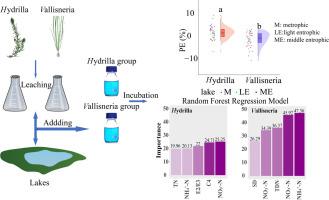Submerged aquatic plants affect the priming effect of dissolved organic carbon degradation in shallow lakes
IF 6.3
2区 环境科学与生态学
Q1 ENVIRONMENTAL SCIENCES
引用次数: 0
Abstract
Aquatic plants have been widely used for lake ecological restoration. The effect of aquatic plants on lake biogeochemical cycling has been investigated intensively, however, plants’ effect on biodegradation of dissolved organic carbon (DOC) is rarely studied. Here we designed an indoor incubation experiment to explore the priming effect (PE) of aquatic plant leaching solution on DOC in shallow lakes, referring to as the input of active dissolved organic matter (DOM) that would arouse changes in the degradation rate of original refractory DOM. Waters from 20 urban lakes of different tropic states were incubated to study their PE on DOC by adding leaching solutions from two submerged freshwater plants, Hydrilla (H) and Vallisneria (V). The study showed a clear influence of aquatic plants on PE with varying directions and intensities. The H incubation group showed a PE range of -6.19 %–9.79 %, with an average of 2.15 % ± 2.70 %, whereas the V incubation group exhibited a PE range of -10.03 % to 3.60 %, with an average of -0.65 % ± 3.11 %. The positive and negative PEs by the two plant species indicate a key role of plants over trophic states on organic carbon dynamics in freshwater lakes. From the perspective of plant leaching input, our results reveal that planting aquatic plants whose leaching solution can reduce PE like V could be used to enhance carbon storage and constrain carbon emission.

沉水植物影响浅水湖泊溶解有机碳降解的启动效应
水生植物在湖泊生态恢复中得到了广泛的应用。水生植物对湖泊生物地球化学循环的影响已被广泛研究,但植物对溶解有机碳(DOC)生物降解的影响研究较少。本研究设计室内培养实验,探讨水生植物浸出液对浅水湖泊DOC的启动效应(priming effect, PE),即注入活性溶解有机物(active dissolved organic matter, DOM)后,会引起原难降解DOM降解速率的变化。本研究对20个不同热带州的城市湖泊水体进行培养,通过添加水螅(H)和水蛭(V)两种淹没淡水植物的浸出液,研究其对DOC的PE。研究表明,水生植物对PE的影响具有不同的方向和强度。H组PE范围为- 6.19% ~ 9.79%,平均为2.15%±2.70%;V组PE范围为- 10.03% ~ 3.60%,平均为- 0.65%±3.11%。两种植物的正、负PEs表明,植物在不同营养状态下对淡水湖有机碳动态具有关键作用。从植物淋溶投入的角度来看,我们的研究结果表明,种植可降低PE(如V)的水生植物淋溶液可以增强碳储量,抑制碳排放。
本文章由计算机程序翻译,如有差异,请以英文原文为准。
求助全文
约1分钟内获得全文
求助全文
来源期刊

Journal of Environmental Sciences-china
环境科学-环境科学
CiteScore
13.70
自引率
0.00%
发文量
6354
审稿时长
2.6 months
期刊介绍:
The Journal of Environmental Sciences is an international journal started in 1989. The journal is devoted to publish original, peer-reviewed research papers on main aspects of environmental sciences, such as environmental chemistry, environmental biology, ecology, geosciences and environmental physics. Appropriate subjects include basic and applied research on atmospheric, terrestrial and aquatic environments, pollution control and abatement technology, conservation of natural resources, environmental health and toxicology. Announcements of international environmental science meetings and other recent information are also included.
 求助内容:
求助内容: 应助结果提醒方式:
应助结果提醒方式:


